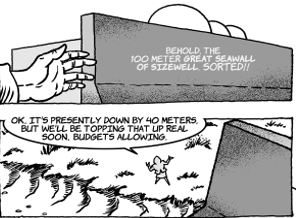
Press Release: Revealed: EDF’s hidden plans for two huge 30-foot-high flood barriers in the heart of East Suffolk’s Heritage Coast and Coast and Heaths AONB.
As part of the much-criticised justification for issuing a nuclear site licence for the controversial Sizewell C nuclear development, the UK’s chief nuclear regulator, the Office for Nuclear Regulation (ONR), has divulged hitherto hidden plans for two sea walls to be constructed in the heart of East Suffolk’s Heritage Coast and the Suffolk & Essex Coast & Heaths National Landscape, designed to provide additional flood protection.
Both walls are proposed to be up to 30 feet high. To the south of the Sizewell C site, the wall will span the ‘Sizewell Gap’ joining Sizewell A’s Sea defences to the cliffs south of Sizewell village. The northern one will span the river in the Sizewell Marshes SSSI, joining Sizewell C’s northern sea defences with higher ground inland at Goose Hill and will be at least 100 metres in length but potentially much longer.
The ONR claims that Sizewell C Ltd, the site’s developer, is ‘committed’ to installing these structures ‘should climate change be worse than is reasonably foreseeable’, despite there being no mention of them in EDF’s application for the Development Consent Order (DCO) for Sizewell C. Therefore, they were absent from the plans approved by the Secretary of State in July 2022 after he had overturned the Planning Inspectors’ recommendation for refusal.
Jenny Kirtley, TASC’s Chairperson, reacted to these revelations, saying, ‘We have come to expect tactics from EDF to get its way when they say one thing then do another, relying on the good nature and tolerance of the communities they disturb and disrupt, but this is an outright cover-up and is further proof, if needed, that EDF thinks it can do as it sees fit with our Heritage Coast.
‘ EDF did not include these plans in the Sizewell C DCO application. However, email correspondence between TASC and the Environment Agency exposes that they and the ONR have been aware of the proposal for these huge structures for ‘several years’ but neither drew them to the Planning Inspectorate’s attention during the DCO examination meaning these structures have not been assessed for their impact on residents, neighbouring properties nor the environment.
‘As spent nuclear fuel will be stored on site till the late 2100s, TASC and other interested parties in the DCO examination raised concerns regarding the risk of flooding from the west, climate change impacts making this more likely, but those concerns were not addressed. The regulatory process has really let us and future generations down as these proposals have not been assessed and if they had been, the potential impact on the environment and burden for future generations could have tipped the planning balance. On that basis, the DCO process itself must be declared flawed.
‘It is yet another slap in the face for our community. It’s time our politicians, regulators and developers began to show the duty of candour, a promised commitment that so characterised Keir Starmer’s pre-election rhetoric’
Notes for the editor:-
- The Environment Agency and the Office for Nuclear Regulation, the UK’s prime nuclear Regulators, state on page 4 of their joint publication ‘Principles for Flood and Coastal Erosion Risk Management’ , “Current and future flood and coastal erosion risk should be managed so that it does not cause unacceptable increases in risk or burden to future generations, and the environment” see Annex 1
- Email correspondence with the Environment Agency confirms that they were made aware of the proposals for the overland flood barriers ‘several years ago’ – see Annex 2 for the email thread.
- On 7th May 2024, the ONR granted Sizewell C Ltd a nuclear site licence, but it should be noted that:-
(i) The site licenced is only 25 hectares whereas Sizewell C requires a minimum 32.5 hectares,
(ii) The ONR have not completed their assessment of whether the site can be kept safe for its full lifetime,
(iii) The ONR have granted the licence despite there being no guaranteed sustainable supply of the 2.2 million litres/day potable water that is essential for Sizewell C’s 60 years of operation,
(iv) Sizewell C Ltd have yet to update their proposals for how to keep the site safe for its full lifetime now they have admitted that spent fuel will not be removed from the site till 2160, 20 years beyond the period claimed in the DCO examination.
(v) Sizewell C Ltd have yet to submit the final design of the sea defences needed to keep the site safe for its full lifetime.
- The diagram below showing the proposals for overland flood barriers that were not included in the DCO documentation, is an extract from the attached ONR document, ‘External Hazards Reassessment’ report (see Annex 3):
5. On 30th August 2024, the Labour government quietly allocated an additional £5.5 billion of taxpayer funds to Sizewell C taking the total government expenditure to £8 billion despite there being no final investment decision and while there are major uncertainties with the project, it still having no guaranteed sustainable supply of potable water, without which it cannot operate, nor final design of its sea defences, without which it cannot demonstrate that the site can be kept safe for its 140 year+ lifetime. TASC have raised these and other issues with the Energy Minister Lord Hunt and local MP Jenny Riddell-Carpenter [see Annex 4], as TASC believe it will be irresponsible to agree a final investment decision while these and other issues remain outstanding, but neither have responded.”
6. TASC’s disappointment with the Regulators compounds that felt during the DCO examination when both the ONR and EA failed to support TASC’s claim that the Sizewell C site lifetime will be longer than that stated by EDF, our claim having since been vindicated when Sizewell C Limited recently admitted that spent nuclear fuel will remain on site until 2160. The timeline for the removal of spent fuel from the Sizewell site was one of the grounds in TASC’s Judicial Review (JR) claim against the Sizewell C DCO decision and while our claim was dismissed by the High Court, recent events, where TASC pressed the issue with East Suffolk Council and they then pressed SZC Ltd, SZC Ltd confirmed TASC’s position to be correct. The length of time spent fuel remains on site matters as the impacts of climate change i.e. rising sea levels, increased storm surges and more extreme weather events, mean that it is more likely that the costly and environmentally damaging adaptive sea defences and overland flood barriers will be needed. Currently the situation is that flood risk modelling both in the approved DCO and for the current ONR site safety case has only been carried out till 2140. TASC find it somewhat disconcerting that it has taken the persistence of a campaign group, rather than government regulators, to establish the full lifetime of the Sizewell site.

